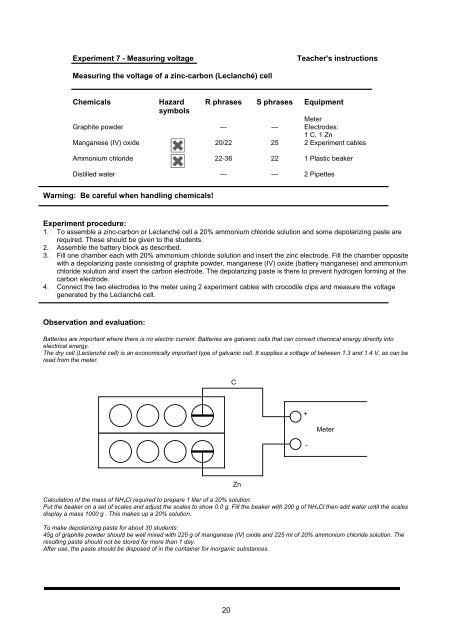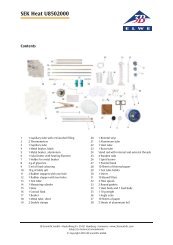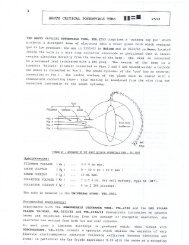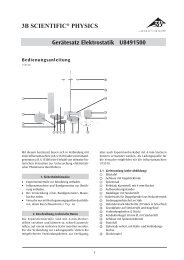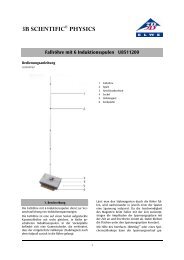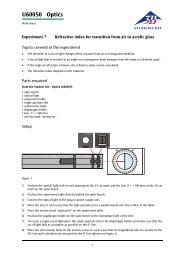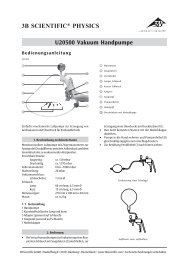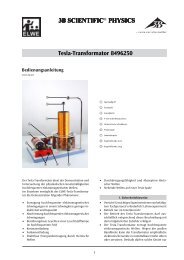3B SCIENTIFIC PHYSICS ELEKTROCHEMIE U11110 ...
3B SCIENTIFIC PHYSICS ELEKTROCHEMIE U11110 ...
3B SCIENTIFIC PHYSICS ELEKTROCHEMIE U11110 ...
Create successful ePaper yourself
Turn your PDF publications into a flip-book with our unique Google optimized e-Paper software.
Experiment 7 - Measuring voltage Teacher's instructions<br />
Measuring the voltage of a zinc-carbon (Leclanché) cell<br />
Chemicals Hazard<br />
symbols<br />
R phrases S phrases Equipment<br />
Meter<br />
Graphite powder ---<br />
--- Electrodes:<br />
1 C, 1 Zn<br />
Manganese (IV) oxide<br />
20/22 25 2 Experiment cables<br />
Ammonium chloride<br />
22-36 22 1 Plastic beaker<br />
Distilled water --- --- 2 Pipettes<br />
Warning: Be careful when handling chemicals!<br />
Experiment procedure:<br />
1. To assemble a zinc-carbon or Leclanché cell a 20% ammonium chloride solution and some depolarizing paste are<br />
required. These should be given to the students.<br />
2. Assemble the battery block as described.<br />
3. Fill one chamber each with 20% ammonium chloride solution and insert the zinc electrode. Fill the chamber opposite<br />
with a depolarizing paste consisting of graphite powder, manganese (IV) oxide (battery manganese) and ammonium<br />
chloride solution and insert the carbon electrode. The depolarizing paste is there to prevent hydrogen forming at the<br />
carbon electrode.<br />
4. Connect the two electrodes to the meter using 2 experiment cables with crocodile clips and measure the voltage<br />
generated by the Leclanché cell.<br />
Observation and evaluation:<br />
Batteries are important where there is no electric current. Batteries are galvanic cells that can convert chemical energy directly into<br />
electrical energy.<br />
The dry cell (Leclanché cell) is an economically important type of galvanic cell. It supplies a voltage of between 1.3 and 1.4 V, as can be<br />
read from the meter.<br />
Calculation of the mass of NH4Cl required to prepare 1 liter of a 20% solution:<br />
Put the beaker on a set of scales and adjust the scales to show 0.0 g. Fill the beaker with 200 g of NH4Cl then add water until the scales<br />
display a mass 1000 g . This makes up a 20% solution.<br />
To make depolarizing paste for about 30 students:<br />
45g of graphite powder should be well mixed with 225 g of manganese (IV) oxide and 225 ml of 20% ammonium chloride solution. The<br />
resulting paste should not be stored for more than 1 day.<br />
After use, the paste should be disposed of in the container for inorganic substances.<br />
20<br />
C<br />
Zn<br />
+ +<br />
-<br />
Meter


